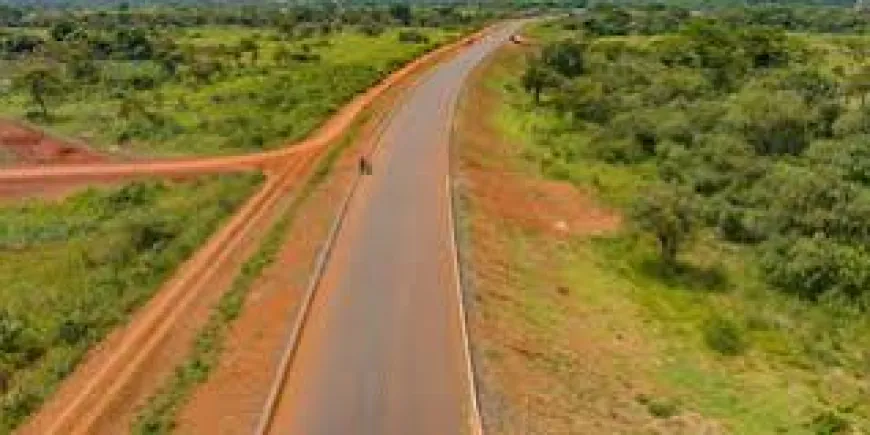Kigoma’s Roads Upgraded: Dust and Mud Now History
The Kabingo-Kasulu-Manyovu highway is 83% complete, transforming Kigoma’s infrastructure and boosting trade in Tanzania’s Western Corridor.

Paved Roads Transform Kigoma: Dust Becomes a Thing of the Past
Wednesday, March 19, 2025
Kigoma, Tanzania – The long-standing struggle with dusty and muddy roads in Kigoma has finally come to an end, as the construction of the Kabingo-Kasulu-Manyovu highway nears completion. For residents and businesses in the region, the new infrastructure marks a turning point, significantly easing transportation and boosting economic activities.
The road, part of the Western International Corridor linking Tanzania with Burundi, Rwanda, and the Democratic Republic of Congo (DRC), has reached an 83% completion milestone. It is a key component of a broader development plan that includes the Tanzania-Burundi International Highway and the Rumonge-Gitaza Road in Burundi, stretching 45 kilometers. The Kabingo-Kasulu-Manyovu section itself spans 260.6 kilometers.
A Game-Changer for Kigoma Residents
Residents of Kigoma and surrounding areas have expressed relief over the transformation, highlighting the immense challenges they previously faced.
"We used to struggle a lot. Traveling from Kigoma to Shinyanga meant arriving covered in dust. For those of us with allergies, the journey was unbearable. Now, that hardship is gone," said Issa Nurdin, a resident of Kasulu.
For traders, particularly those dealing in maize, the improvements are equally significant.
"During the rainy season, transporting goods was a nightmare. The roads turned into mud, increasing transportation costs. Now, things are easier, and even transport charges have stabilized," noted Nyalusi Maira from Kibondo.
Retired Catholic Bishop Methodius Kilaini shared his amazement at witnessing the transformation.
"I never thought I would see a paved road from Kigoma to Bukoba. Seeing this now, I must commend President Samia Suluhu Hassan’s government," he remarked.
Progress on Construction
Speaking on the status of the project, Dr. Charles Msonde, Deputy Permanent Secretary at the Ministry of Works, confirmed that construction is progressing in four phases, covering five constituencies: Buhigwe, Kasulu Urban, Kasulu Rural, Muhambwe, and Buyungu.
- Phase 1: Kasulu-Manyovu (68.25 km) – 84.3% complete, expected completion by May 31, 2025
- Phase 2: Kanyani Junction-Mvugwe (70.5 km) – 75.3% complete, expected completion by October 30, 2025
- Phase 3: Mvugwe-Nduta Junction (59.35 km) – 90.7% complete, expected completion by May 7, 2025
- Phase 4: Nduta Junction-Kabingo (62.5 km) – Fully completed, currently under monitoring
The project also includes a 45-kilometer stretch in Burundi (Rumonge-Gitaza), ensuring seamless connectivity between the two countries.
"The road has been designed with a TLC 20 durability rating, an 11-meter width, and modern drainage systems to prevent soil erosion. Large and small culverts have been installed alongside key road safety markers," Dr. Msonde explained.
He emphasized that the project is expected to stimulate economic growth in Kigoma and neighboring regions while strengthening cross-border trade with Burundi, Rwanda, Uganda, and DRC.
Parliamentary Oversight and Funding
On Tuesday, March 18, 2025, members of the Parliamentary Public Investment Committee (PIC) inspected the project, which is being funded through a loan from the African Development Bank (AfDB).
Committee Chairperson Augustine Vuma Holle, who is also the MP for Kasulu Rural, expressed satisfaction with the progress.
"The quality of the construction is commendable. This project is a game-changer for Kigoma and the entire Western Corridor," he stated.
However, concerns were raised about an additional TZS 80 billion incurred on the TZS 400 billion project. Francis Ndulane, a committee member, inquired about the cost increase.
Responding to the query, Dr. Msonde clarified that the additional costs were due to severe El Niño rains, which caused sections of the road to collapse, particularly in Busungu along the Mvugwe-Nduta Junction stretch.
"The unexpected rainfall eroded the soil completely. This was an environmental challenge beyond our control. Tanroads and the contractor had to deploy additional workforce and equipment to address the damage," he explained.
Despite these challenges, the government remains committed to ensuring contractors adhere to deadlines and deliver the highest construction standards.
"At 83% completion, this is one of the most significant infrastructure projects in Kigoma's history. The dust problem is gone, and transportation to Mwanza and Shinyanga is now seamless," concluded Holle.
What's Your Reaction?
































